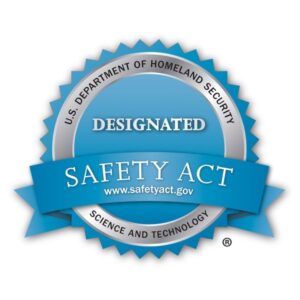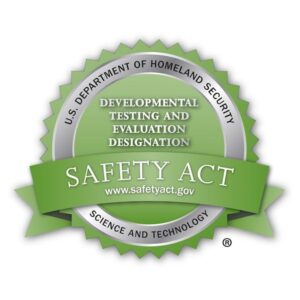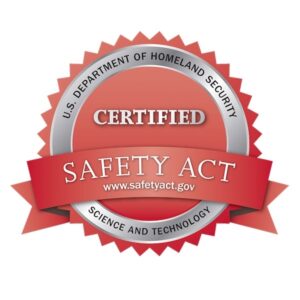SAFETY Act
Quick Facts
About the Act
The impetus of enactment of the Act was due to catastrophic losses of 9/11. Following 9/11, there was a perceived inevitability of acts of terror and the private sector had strong concerns with duty assumptions. Congress enacted SAFETY Act in 2002, to promote emergency preparedness in the private sector creating liability limitations to incentivize.
The SAFETY Act provides important legal liability protections for providers of Qualified Anti-Terrorism Technologies, whether they are products or services. The goal of the SAFETY Act is to encourage the development and deployment of effective anti-terrorism products and services by providing liability protections.
There are two levels of protection available under the SAFETY Act.
Designation
 A technology must demonstrate effectiveness during operational testing or through prior use. Designation provides a liability cap as well as exclusive action in Federal court, no joint and several liability for non-economic damages and no punitive damages or prejudgment interest. An applicant is required by the SAFETY Act to obtain liability insurance in the amount of the specified liability cap certified by the Secretary. A full Designation normally lasts for five years, after which time it can be renewed. Any technology deployed during its period of Designation is protected for the lifetime of its deployment.
A technology must demonstrate effectiveness during operational testing or through prior use. Designation provides a liability cap as well as exclusive action in Federal court, no joint and several liability for non-economic damages and no punitive damages or prejudgment interest. An applicant is required by the SAFETY Act to obtain liability insurance in the amount of the specified liability cap certified by the Secretary. A full Designation normally lasts for five years, after which time it can be renewed. Any technology deployed during its period of Designation is protected for the lifetime of its deployment.
If a technology shows promise but is not sufficiently mature to receive a full Designation, a Developmental Testing and Evaluation (DT&E) Designation is available to provide protection during further testing or trial deployment in order to collect the additional efficacy data necessary for a full Designation. A DT&E Designation provides similar liability protections as that provided by a full Designation but with certain limitations and constraints.
In general, DT&E Designations will include limitations on the use and deployment of the subject technology, remain terminable at-will by the Department should any concerns regarding the safety of technology come to light, and will have a limited term not to exceed a reasonable period for testing or evaluating the technology (presumptively not longer than 36 months). Further, the SAFETY Act liability protections associated with DT&E Designations will apply only to acts that occur during the period set forth in the particular DT&E Designation.
- DESIGNATION/DEVELOPMENTAL TESTING AND EVALUATION DESIGNATION:

- Liability insurance limit is determined by DHS and all claims are limited to that amount
- No punitive damages and no prejudgment interest
- No joint and several liability for non-economic damages
- No non-economic damages if there is no physical harm
- Recovery reduced by all collateral sources
Certification
 In addition to the benefits provided under Designation, Certification allows a seller of anti-terrorism technology to assert the Government Contractor Defense that immunizes Sellers from liability for claims arising from acts of terrorism. Technologies that receive Certification will be also placed on an Approved Products List for Homeland Security.
In addition to the benefits provided under Designation, Certification allows a seller of anti-terrorism technology to assert the Government Contractor Defense that immunizes Sellers from liability for claims arising from acts of terrorism. Technologies that receive Certification will be also placed on an Approved Products List for Homeland Security.
- CERTIFICATION:
- Benefits of Designation +
- ABILITY TO ASSERT THE GOVERNMENT CONTRACTOR DEFENSE
SAFETY Act Services
- Formulation of optimized Qualified Anti-Terrorism Technology (QATT) description for Seller
- Preparation, organization, synthesis and submission of SAFETY Act Pre-Application and necessary supporting documentation
- Formalized preparation of security program stakeholders in preparation of DHS-led site visit
- Organization and facilitation of DHS-led site visit. Site visit is normally a requirement for Seller’s submission of a final SAFETY Act application and is used as a vehicle for DHS to evaluate whether the program’s function follows form and, more specifically, the Seller’s conformances with specifications as stated.
- Preparation, organization, synthesis and submission of SAFETY Act Final submission and necessary supporting documentation
- Facilitate and manage DHS application evaluation processes and inquiries and/or requirements disseminated thereto
- Award maintenance through resiliency services, which could include the following:
- Contour coordination
- Continual review, analysis and revision, as may be necessary, of security program component parts
- Continual collection and review of sample sets in contemplation of renewals or modification request

SAFETY Act Consultancy Services
- Security considerations related to development and design direction
- SAFETY Act award considerations
- Type of protection:
-
- Best practice model
- Security program
- Protective design
- QATT development OSAI liaison
- Organizational benefits and limitations/obstacles
- Roadmap/timeline specific to SAFETY Act goals

SAFETY Act Submission Preparation
- Collection, evaluation and analysis of supporting documentation
- Real-time observation as gleaned through internal and SAFETY Act mandated site visits
- Collaboration in support of operational functionality

SAFETY Act Site Visit Facilitation
Organization of Security Program SAFETY Act applicant two-day Site Visit through agenda setting and synthesis of all information collected and observed during the Visit for incorporation into the final SAFETY Act Application submission.

Resiliency Services
Entrenchment, maintenance and enhancement of SAFETY Act infrastructure and organizational defined goals.
-
Receipt, review, organization and assimilation of annual SAFETY Act supporting documentation sample set
-
Review and update of supporting plan documents
- Consultation opportunities in support of:
- QATT
-
Threat and Vulnerability Studies
- OSAI liaison responsibilities:
-
- Communicate necessary updates
- Ensure award viability
- Support award maintenance requirements through Contour response program
- Award elevation effort

Global Benefits













